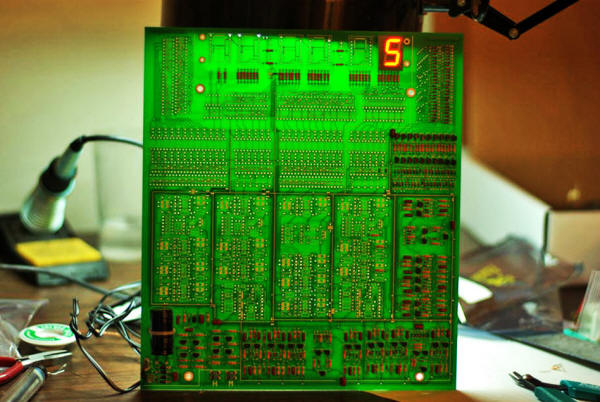|

by Michael J. Biercuk
May 16,
2011
from
TheConversation Website
Spanish
version
|
Dr.
Biercuk performs experimental research in quantum
physics. His research is funded by the United States
Army Research Office, the Australian Research Council
through the Centre of Excellence for Engineered Quantum
Systems, and the School of Physics and Faculty of
Science at the University of Sydney. |

This might surprise you, but there may be literally thousands, or
even tens of thousands, of devices and components surrounding you
right now that work because of our understanding of quantum physics.
Before you ask, it doesn't include your dishwasher detergent.
Quantum Physics is a branch of
science that engenders huge amounts of interest, awe, and, more
often than not, bewilderment.
But before we can tell
you how it really impacts you, we need to provide a little bit of
background.
OK, give me the
theory
Quantum Physics is focused on explaining the behavior of
matter and light at very small scales - single atoms and
photons ("particles" of light).
The mathematical
formalism of quantum mechanics (distinguished from the broader term
quantum physics) allows scientists to model the physics being
probed through experiments.
There's nothing unique about quantum physics - it's a scientific
theory just like any other, meeting the rigorous requirements of the
scientific method.
But there are certainly some strange aspects of the theory.
The word "quantum" is defined by the Oxford English Dictionary
as meaning,
a quantity, share, or
portion...
It was applied to
pioneering studies of the nature of light and matter because
experiments suggested that a wide variety of measures came with only
very particular allowed values - quite contrary to what we generally
observe in the world around us, or standard physical intuition.
It gets stranger...
In quantum physics nobody can tell you much with any certainty. They
can only describe probabilities for measurement outcomes
(e.g. where a particle might be). And quantum physics describes
light as being both a
particle and a wave at the same time...
Why is the theory so counterintuitive?
Well, unfortunately that
remains the subject of much study, including the active research
field of quantum foundations, trying to elucidate what's really
going on.
Despite these quirks, quantum physics has become one of the most
successful scientific theories developed to date, permitting
scientists to explain a range of behaviors in systems from stars to
gases, metals to light.
Most importantly, the theory has predictive power, a key requirement
in science.
What about all
those quantum applications?
Let's begin with IT...
Transistors are the
fundamental hardware elements in microprocessors - they
represent bits of information in the way they conduct
electricity (on = 1, off = 0).
Transistors are fabricated from materials known as
semiconductors, in which charge-carrying electrons are only
allowed to occupy certain discrete energy levels, as determined
by quantum physics. As more electrons are added they form
allowed "bands" in a prescribed manner.
The resultant energy "bandstructure," which can be modified by
applying voltages to wires connected to the device, gives rise
to the switching behavior from which we build fundamental
electrical elements.
Without quantum mechanics we would have no understanding of
semiconductors, could not have engineered the transistor, and
thus would have no microprocessors.
Similar things can be
said about other familiar IT devices in your office.
Mobile phones, for
instance, use high-frequency circuits that function thanks to
the same physics.
On the internet, network time is kept by atomic clocks which use
the quantum description of atoms and light-matter interactions
to produce an extremely stable and repeatable "tick."
In fact, almost every piece of information technology hardware -
from microprocessors in desktops and servers to optoelectronic
modulators and laser diodes used in long distance communications
for the internet owe their existence to our understanding of
quantum physics.
Anything outside the
office?
At home, if you turn
on your flatpanel television it may well have what's known as an
LED-backlit display. This uses an energy-efficient light source
know as a light-emitting diode.
The quantum physics of semiconductor bandstructure and
Planck's theory of radiation
explain how to produce light of various colors from these
devices.
Your home entertainment system may also have a DVD player that
uses a solid-state laser, the development of which was based on
Einstein's
quantum theory of radiation and later developments in
stimulated emission.
Or if you had an MRI for a knee injury, that functioned thanks
to developments in nuclear magnetic resonance and the quantum
theory of "spin"
angular momentum.
We could go on and on …
To be clear, these aren't technologies that can be torturously
traced back to quantum theory - these are devices and systems that
were developed explicitly because of our knowledge of quantum
physics.
So now you
know
The real, everyday impacts of quantum physics have been obscured by
marketers who use the word "quantum" relentlessly to suggest that
their products are "high-tech," in applications as diverse as data
storage and, yes, dishwasher detergent.
Similarly, New-age groups
have co-opted "quantum" and used it to mean pretty much any absurd
pseudo-religious idea they wish.
All of this is bunk.
But now if someone
tries to sell you something because it's "quantum" you can
separate truth from nonsense.
And if you question why this branch of physics matters to you,
just look around and you'll see the answer in nearly all of
modern technology.
| 

